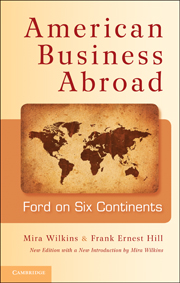Book contents
- Frontmatter
- Contents
- List of Illustrations
- Preface
- Introduction to the New Edition
- Introduction to the First Edition
- 1 First Venture
- 2 Probing for Markets
- 3 Model T: Triumph and Fable
- 4 The Alchemy of War
- 5 Steps in Expansion
- 6 The Sun Never Sets
- 7 Prosperity and Frustration
- 8 The Missionary Spirit
- 9 The Best-Laid Plans
- 10 Marriage of Convenience
- 11 Time of Desperation
- 12 A World Disturbed
- 13 Extreme of Nationalism
- 14 The British Empery
- 15 On Both Sides of World War II
- 16 The Crippled Phoenix
- 17 The New Company
- 18 Manufacturing for World Markets: From Dagenham to Geelong
- 19 New Times, New Faces, New Policies
- Appendices
- Bibliographical Essay
- Notes
- Index
- Titles in the series
- Plate section
11 - Time of Desperation
Published online by Cambridge University Press: 05 June 2012
- Frontmatter
- Contents
- List of Illustrations
- Preface
- Introduction to the New Edition
- Introduction to the First Edition
- 1 First Venture
- 2 Probing for Markets
- 3 Model T: Triumph and Fable
- 4 The Alchemy of War
- 5 Steps in Expansion
- 6 The Sun Never Sets
- 7 Prosperity and Frustration
- 8 The Missionary Spirit
- 9 The Best-Laid Plans
- 10 Marriage of Convenience
- 11 Time of Desperation
- 12 A World Disturbed
- 13 Extreme of Nationalism
- 14 The British Empery
- 15 On Both Sides of World War II
- 16 The Crippled Phoenix
- 17 The New Company
- 18 Manufacturing for World Markets: From Dagenham to Geelong
- 19 New Times, New Faces, New Policies
- Appendices
- Bibliographical Essay
- Notes
- Index
- Titles in the series
- Plate section
Summary
By the late spring of 1930 the prospects for the tractor plant in Cork, Ireland, already looked grim. E. L. Clarke, the manager, wrote to Perry on May 14 that he was discussing an order for 4,000 tractors with the Russians but saw no agreement ahead on credit arrangements. And if no agreement were reached, “We shall be forced to shut down practically all departments.” Negotiations proceeded, but work at the factory did not. “We have had to lay off almost 6,000 men during the past three weeks,” wrote Clarke to H. S. Cooper on June 5, “which is a very serious consequence in a city of this size. … Naturally these men are all on the dole.” By August the Cork factory was a ghost plant.
What had caused this sudden collapse? Six months earlier Clarke could not get enough men or pour out tractors enough. To be sure, Russian orders had helped to swell the volume of business, but they had been only the largest among others from many parts of the globe. The truth was that the automotive business was running head on into the growing economic depression which Henry Ford had been refusing to recognize. Spreading out from the United States, where it had affected American capital and government, like a collapsing house of cards it had now wrecked their European counterparts. For during the 1920's the nations most affected by World War I had looked to America as they had rebuilt their shattered economies.
- Type
- Chapter
- Information
- American Business AbroadFord on Six Continents, pp. 228 - 252Publisher: Cambridge University PressPrint publication year: 2011

